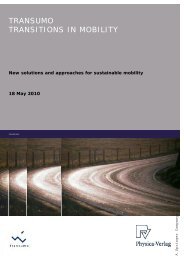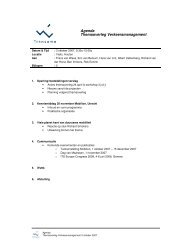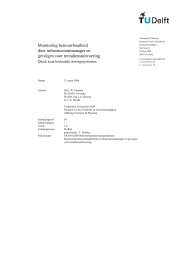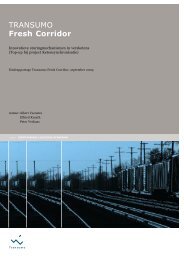Casestudie Breakdown prediction Contell PILOT - Transumo
Casestudie Breakdown prediction Contell PILOT - Transumo
Casestudie Breakdown prediction Contell PILOT - Transumo
Create successful ePaper yourself
Turn your PDF publications into a flip-book with our unique Google optimized e-Paper software.
This idea would allow recognition of changes within very short time. Nevertheless, it<br />
is not promising because the single cooling cycles differ from each other due to<br />
technical and other reasons. 68 Hence, an appliance of this method would lead to a<br />
high quantity of additional false alarms.<br />
The second idea is based on the assumption that temperature sequences of cooling<br />
devices may not contain a trend on the long-run. To obtain a presumable trend, a<br />
linear regression function could be used. In case of a good fit (coefficient of<br />
correlation ≥ 0.9) 69 the gradient of the regression function determines the trend. As<br />
already mentioned, this method is only promising on the long-run, because linear<br />
regression functions on the short-run are highly influenced by outliers. 70 This would<br />
lead to a too small coefficient of determination.<br />
5.10.3 Classification by Using Past Behavior<br />
As a real malfunction is very improbable and the current number of alarms leads to a<br />
loss of credibility, more system states have to be made up than just “OK” and<br />
“Malfunctioning”. 71 Moreover, most alarms are user made due to door openings<br />
[Nijmegen06]. An appliance of data mining methods may provide these additional<br />
system states. The main idea is, to compare current behavior to similar situations in<br />
the past and the succeeding developing.<br />
Therefore, classification of alarms into different levels (e.g. green, yellow, red) could<br />
be used to indicate how critical a current temperature exceeding is. To achieve such<br />
a classification, every alarming situation is compared to all other situations in the<br />
past. The general assumption is that an alarm is only classified as a red one, if it is<br />
significantly different to most previous ones. Furthermore, alarms that cannot be<br />
connected to a previous door opening should immediately be classified as a red<br />
alarm. To be able to classify the door made alarms, different criteria have to be<br />
found.<br />
A promising suggestion is the usage of the following criteria:<br />
• The duration of door openings<br />
• The maximum temperature during an alarm<br />
• The maximum duration of an alarm<br />
68 See section 2.3 for details<br />
69 See section 5.4.2 for details<br />
70 See Figure 5-2 for details<br />
71 See section 4.3.2 for details<br />
82
















